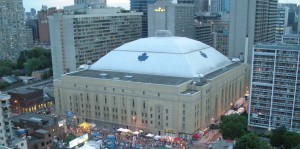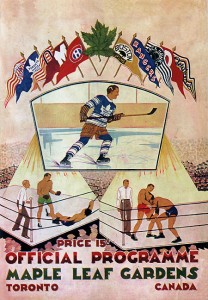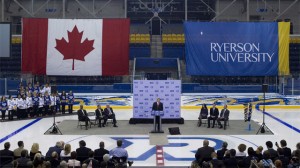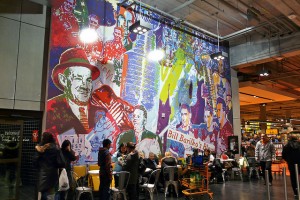Site Analysis – Maple Leafs Gardens
Maple Leafs Gardens. 60 Carleton St. Toronto, ON.
Introduction and History:
Maple Leafs Gardens, also known as MLG, has definitely changed from what it used to be in the past. From the outside, on the Corner of Carleton and Church Street in Toronto, it still looks the same as from the time it was built, but has changed drastically on the inside. The space, remembered today as an iconic hockey arena, is now being used for groceries, shopping, and dining. Loblaws is the main attraction but there is also an ice rink which belongs to Ryerson University. The dynamics and structure of this new Maple Leafs Gardens has been altered greatly but still manages to preserve a little piece of history.
Maple Leafs Gardens first opened its doors on November 12th 1931 (mattamy athletic center). The project began when the managing director of the Leafs, Conn Smythe, began to realize the growing popularity of professional hockey, but understood that there were physical limitations in regards to the space on the ice, as well as many other costly issues, and was concerned with the amount of money it would cost to accommodate enough space for all the fans (historic canada). Smythe was unable to fund the project on his own and had to take out bank loans and sell stocks. The land was eventually purchased from Eaton’s and the first bricks were laid on May 1st 1931 (historic canada).
This larger building would provide enough space for the growing fans of Toronto. Built in only seven months, it was the largest arena in the country at the time (mattamy athletic center). Located at the corner of Carleton and Church Street, The Gardens allowed Canada with a space to participate in the ground-breaking popular culture that was shaping the Century (mattamyathleticcenter.ca). It was one of Canada’s national treasures (histori ccanada). For almost 68 years, the Gardens was the home of one of the “Original Six” hockey teams, the Toronto Maple Leafs (historic canada).
The Gardens opened in 1931 with the Toronto Maple Leafs facing off against the Chicago Blackhawks. The best seats in the house were being sold for $2.75 (historiccanada.ca). Although they lost that first game, the Leafs had years of magic happen for them within that arena. They managed to win the Stanley Cup during their first year at the Gardens (mattamy athletic center), and eventually won 10 more during the time period of 1941 and 1967 (historic canada). The last game the Leafs ever played at the Gardens was coincidentally against the Chicago Blackhawks on February 13 1999. They lost yet again, but a record-breaking amount of fans attended the game that year (historic canada).
Other sports teams took advantage of this new space as well and established themselves within it. There were wrestling matches and boxing tournaments that were held there. The Gardens made history in February 1936 for holding the largest crowd in boxing history during the tournament (historic canada). That was a first for the Gardens along with many more, like hosting the first game of the NBA in 1946, as well as hosting the first official NHL All-Star game which is a tradition still honoured today (mattamy athletic center).
Other than sports, Music was a huge part of the history of the Gardens. Looking back now, this venue was host to many historical legends like Muhammad Ali, Winston Churchill and Elvis Presley (mattamy athlectic center). Elvis Presley played his first ever show outside of the United States at the Gardens in 1957 (mattamy athletic center).The Gardens continued to make history being the only venue to accommodate the Beatles on all three of their North American tours in the 1960s. They also hosted concerts by Bob Hope and Frank Sinatra (mattamy athletic center). In 2007, the Gardens was recognized as a National Historic Site of Canada (mattamy athletic center).
In November 2011, the doors would open once again in over a decade. However, this time it was opening as a supermarket, clothing store, LCBO outlet, and an athletic center (Lavelle, 2011). Loblaws bought the arena in 2004. In 2009 it was announced that the building would become the athletic home of Ryerson University (Perkins, 2012). The space created during the renovation would open up many facilities. Along with the NHL-sized ice rink, basketball and volleyball courts were also included, as well as about 1200 bleacher seats, a four-lane 200 meter running track, and a fitness center and gym (Brown, 2009). The Gardens is now known as Mattamy Athletic Center and is no longer to be called Maple Leafs Gardens (Perkins, 2012). The only place that still holds that historic name is the sign on the front of the building on Carlton St. It will not be changed because the place is on the national register of historic landmarks (Perkins, 2012).
The history of the Maple Leafs Gardens is a huge part of history within Toronto. It created a space for people to be able to experience music, moments, and togetherness. The hockey rink, that was home to the leafs, provided enough space to accommodate the ever growing fans. Concerts were intimate and allowed for legendary experiences that have been recorded in history.
Analysis
When I visited the Maple Leafs Gardens for the first time, I had already done research on what it used to look like prior to 1999. The changes that have been made are extreme. It doesn’t look a thing like it used to. There is still, however, a full-sized ice rink that accommodates over 2600 fans but with many other facilities added to the building than before. There is a Loblaws, Liquor Store, clothing store on one side. The other side is now the ticket office for Mattamy Athletic Centre which has, on the 2nd floor, volleyball/basketball courts, an advanced gym, and a cafe. The Third floor is the ice rink and dressing rooms for hockey. The Fourth floor is the Alumni lounge, seating for the arena, and two concessions stands. There is a lot of free space to wander around upstairs. For the purpose of this assignment, I will focus majority of my analysis on the Grocery store since it happens to be the main attraction now.
The Loblaws at the Maple Leafs Gardens is the biggest grocery store I have ever seen and probably will ever see in my lifetime. There is an extensive amount of space between everything allowing for more people to be able to fit. The aisles are spacious and the shelves seem higher than normal. The interesting thing about this Loblaws, other than how big it is, is its location. The fact that it is where so many historical events have taken place explains a lot of the differences between this Loblaws and so many others.
The walls within the building are filled with old photos of legends that have stepped foot on these grounds in the past, and the events that have established this building as a historical landmark. There is a Maple Leaf wall sculpture made of old chairs from the arena as well. Even though I was standing in a grocery store, I felt like I just stepped into a museum of hockey and musical legends. The paintings looked like they were touching the ceiling. The roof itself provided so much light and made the whole store seem more open somehow. The most interesting thing I saw there was a red dot on the ground in aisle 25. When I asked what it was for, I found out it was to mark the center ice from when the Maple Leafs would play here. That is a huge piece of history that they didn’t destroy and seems to be something of great attraction there.
39 year old Chris Palermo, who was dining there with his wife, told me about his excitement when he found out that the building was to reopen finally after over a decade. “We come here often. It’s not far from where we live. We heard it was really good food and wanted to see for ourselves. And I used to come here when I was a kid so when I heard that they were reopening the building, I was excited to see what they did to it.” I was curious to see whether he was disappointed with what they had done to the Gardens and how he would compare his experience then to what it is now. “To be honest, you can’t really compare the two because they’re completely different. I used to practice and play here when I was a kid. The smoothest milky ice ever. First row of the Greens were all we could afford but still perfect. I remember being here when I was a kid and black Sabbath was so loud I couldn’t hear properly for 3 days. It was definitely a fantastic experience, but incomparable to a grocery store that’s for sure.”
This Loblaws, although a grocery store, didn’t really sound like one. Normal sounds of grocery stores consists usually of yelling parents, soft music from the ceilings, scanners beeping as people are cashing out, and shopping carts hitting against things due to lack of space. If I were to close my eyes in the middle of this store, it would sound like a café/restaurant. The atmosphere wasn’t chaotic like how you’d experience a grocery store, but it was full of life. There are free samples of food being offered almost at every turn. Because of these features, there are many people in the area who shop here often and on a regular basis.
Zandra Moustaz is a 28 year old regular shopper, who seemed very pleased with everything this Loblaws has provided. “It’s fun to sit at the tables that have pictures of past events while having a muffin and cup of coffee. I enjoy not bumping into people continuously because of how much room there is to navigate throughout the store. I definitely won’t be able to go back to another small, crowded, loud, grocery store ever again because of this one.”
However, not everyone seemed to have the same experience as Zandra. There are many people who visit this grocery store now, that have also visited the Gardens before the renovation. David Emslie, a 66 year old shopper, was fortunate enough to experience the Maple Leaf Gardens when it was still the home to the Toronto Maple Leafs. He was very vocal about what he thinks of this enormous renovation of the venue. When I asked him what he thinks about the grocery store replacing this historical ground he stated “a huge waste of space for some produce. The obnoxious orange floors are a headache to stare at, while trying to find what you’re looking for in the gigantic store.” His experience at the previous version of the Maple Leafs Gardens has definitely affected his experience of the new version. He says “I Grew up watching games here. The atmosphere was unreal. Everything from the smokey hall ways to the deafening crowds. Anyone who ever watched a game here will tell you the same thing. Now? It’s a shame to see what it has become.” Although David continues to shop at this Loblaws, his disappointment is evident.
In my experience, the biggest difference between this grocery store and others, apart from the spatial aspect, was the live music. I discovered that this Loblaws provides their shoppers with live music and entertainment. It was a completely different experience that I’ve never had before. Even though I wasn’t grocery shopping, just being in a space that’s not a bar or a concert hall, but still being able to listen to live music was amazing. It seemed to be a big part of other people’s experiences as well. These bands were not overlooked like musicians in a subway station; they were respected as if they were performing in a concert hall like the ACC. Many people would stop and listen, and it was obvious that it added positively to their experience at the grocery store. The live music was by far the sound mark of this Loblaws because it is the only one that plays live music as opposed to music from a distant speaker in the ceiling.
It was interesting to see how many different types of people enjoyed this live band. This relates directly to Sara Cohen’s ethnography and how she describes culture as “musical pathways,” which shows how dynamic the individuals within a culture can be. It becomes something that people can use to relate to one another and especially within this grocery store a different experience for many. Music is produced, according to Cohen, through social interactions and within context (Cohen, 267). These same musicians could be performing on the streets and may not get one glance, but by performing in a one of a kind grocery store, it changes and enhances the experience for the customers. Zandra relates by saying “Excellent food….with live music….where else can you do food shopping like this?”
There have been many changes made to this venue over the years, but for someone like myself who has never visited the old Gardens, it was definitely far from a disappointment. People were standing and staring at the paintings on the walls, and it felt more like a museum at times. Even though there are probably many people like David Emslie who find it to be a disgrace that the venue was turned into a grocery store, there are also many people like Chris Palermo who are disappointed but embrace the new Gardens. Chris puts it into perspective by saying “My memories of concerts, hockey games and
Ice Follies have now moved away to make room for this new complex. If you can’t take change and you want to keep your memories in tack, don’t visit. You lose a bit of your childhood when you see the changes. BUT at the same time, this place was sitting here for years and it’s about time they made good use of the space.”
The overall experience at this specific location was definitely a unique one. Aside from comparisons between the old and new Gardens, people seemed fairly content with their experience in the current. By providing a liquor store, bank, gym, live music etc., convenience and comfort of the customer are key. Customers are provided with an experience like no other grocery store.
Bibliography
1. S. Cohen – “Sounding Out the City: Music and The Sensuous Production of Place” from The Place of Music, Leyshon, A., Matless, D., and Revill, G. (eds), New York: The Guilford Press, 1998
2. Historica Canada. Maple Leaf Gardens | Historica Canada.” Historicacanada.ca, 2013. Web. <https://www.historicacanada.ca/content/heritage-minutes/maple-leaf-gardens>.
3. Mattamy Center. “Mattamy Athletic Centre :: Highlights & History.” Mattamyathleticcentre.ca, 2013. Web. <http://www.mattamyathleticcentre.ca/arena-info/arena-highlights-history>
4. Perkins, Dave. “A new house of hockey rises out of old Maple Leaf Gardens: Perkins | Toronto Star.” Sept. 14th, 2012.
5. Brown, Brendan. “Gardens to reopen in 2011 | Toronto Star.” Dec. 1st, 2009.
6. Flavelle, Dana. “Maple Leaf Gardens: From shrine to supermarket | Toronto Star.” Nov. 25th, 2011.
Pictures
7. Flavelle, Dana. “Iconic Maple Leaf logo going, going….gone | Toronto Star.” thestar.com, 2011. Web.
8. “Maple Leaf Gardens.” Wikipedia, 2013. Web. <http://en.wikipedia.org/wiki/Maple_Leaf_Gardens>
9. “Maple Leafs Mural, Loblaws, Maple Leaf Gardens, Toronto.” Flickr, 2013. Web. <http://www.flickr.com/photos/castelmar/6713334339/>.
10. Kretzel, Lasia. “Stephen Harper helps Ryerson unveil new digs at old Gardens.” National Post, 2013. Web. <http://news.nationalpost.com/2012/08/13/stephen-harper-helps-ryerson-unveil-new-digs-at-old-gardens/>.



